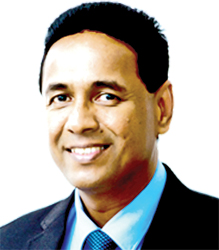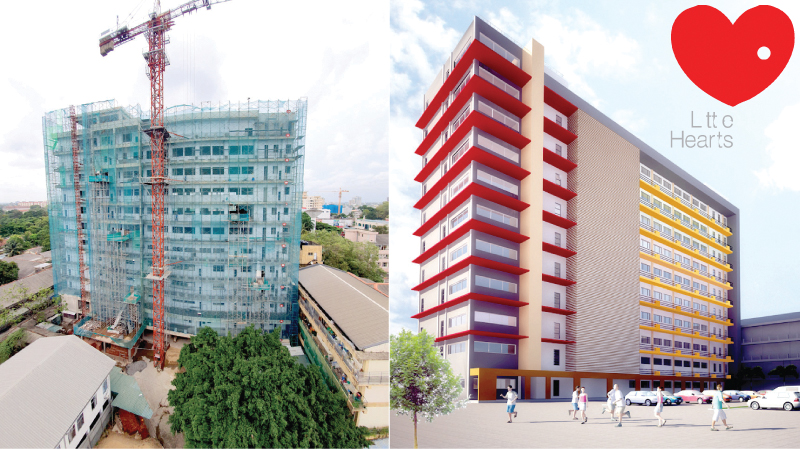Heart diseases have surged in the recent past globally and in Sri Lanka. Tragically, the most vulnerable to such diseases are children, many of whom don’t live to even celebrate their first birthday. The Sunday Observer spoke to Consultant Paediatric Cardiologist, Lady Ridgeway Hospital for Children, Dr. Duminda Samarasinghe to find out the causes for such diseases in children, how they could be prevented , and how timely treatment can help them lead productive lives despite their infirmities.
Excerpts.

Dr. Duminda Samarasinghe
Q: Two days ago cardiologists observed another World Heart Day on September 29. Why is this day so important that a special day has been set aside to observe it?
A. Because Cardiovascular Disease has surged worldwide in recent years. Hence it is urgent that the attention of the world community be brought to this disturbing fact with increased awareness raising of cardiovascular diseases including their prevention and their global health impact.
Q: This year’s theme for World Heart Day is ‘Use Heart, Know Heart.’ Does this theme endorse that goal- especially regarding Congenital Heart Disease (CHD) which remains a critical health issue in many countries including Sri Lanka requiring urgent attention?
A. Yes. The idea is to enlighten the public on heart so that they will ‘use’ it better.
Q: How common is Congenital Heart Diseases (CHD )in Sri Lanka at present?
A. According to estimates, out of every 1,000 newborn babies, 8 are born with a congenital heart disease. In Sri Lanka, 330,000 babies are born every year.
Therefore, we should have around 2,500 to 3,000 babies born with CHD every year.
Q: Yet despite this growing number there seems to be little understanding among many parents of children with congenital heart diseases, on what exactly the disease is. So tell us, what is CHD?
A. CHD is defects in the heart that are there from birth. They can be a hole in the heart, a narrow valve or combination of many such defects leading to a more complex lesion.
Q: What are the main causative factors?
A. In utero, the heart forms in a very complex manner. If there is a minor deviation in the process, it ends up as a CHD. For most of them there is no specific reason. But genetic syndromes, drugs taken by the mother during pregnancy, maternal infections during pregnancy are some causes for CHD in the baby.
Q: What are the chances for an infant with a family history of heart diseases to develop CHD?
A. Depending on the lesion and the relationship to the baby the risk varies. The population risk of getting a CHD is around 1 percent but it increases to 3 to 10 percent when there is a family history.
Q: Does the age of the mother at delivery matter in increasing vulnerability risks for the infant?
A. When the mother is older, the risk of syndromes like Down syndrome is higher. These babies have a higher risk for CHD. So babies born to older mothers have a higher risk for CHD.
Q: Are there different types of congenital heart defects? If so, which are the commonest?
A. Holes in the heart like Atrial septal defects (a hole between the two upper chambers of the heart) and ventricular septal defects (a hole between the two lower chambers of the heart) are the commonest CHDs. Out of the cyanotic CHD where the baby becomes blue, Tetralogy of Fallot is the most common.
Q: Can they be detected and prevented before the baby is born?
A. Most of the CHDs can be diagnosed in foetal life by performing a fetal echocardiogram However; you can’t prevent them through early detection. If detected and treated early, you can prevent those getting complications.
Q: What are the early signs /symptoms that parents should lookout for and when do they first appear ?
A. If they have cyanosis, (persistent bluish discoloration of lips, tongue and fingers) it is a definite indication for evaluation of the heart. Rapid breathing or difficulty in breathing, rapid heart rate, inability to feed, head sweating, recurrent chest infections and easy fatigability are some features that parents should look for and be alarmed of.
Q: How do such defects impact on the child’s growth and development?
A. First, it can have an effect on the weight and height of the child. Then it also affects their ability to participate in sports and other activities. There can be some issues with their neurodevelopment especially with cyanotic heart diseases.
Q: Which of these defects do you consider as the most critical?
A. Cyanotic heart diseases are more critical and some have to undergo surgery immediately or within a few weeks of life.
Certain holes in the heart like VSD (hole between the two lower chambers of the heart) and PDA (hole between the two great vessels) can cause issues especially if the defect is large and if the child gets a chest infection.
Q: What is the usual procedure followed when a child is brought to a hospital with CHD like symptoms?
A. First it is suspected on clinical examination by a qualified doctor. Then if relevant they will order an ECG or a chest x-ray, But the definite diagnosis is done through an echocardiogram.
If further information is required the patient may be subjected to a cardiac catheterisation. If relevant we will do an ECG or a Chest X ray and proceed for an echocardiogram. With the current day echocardiography machines these lesions can be identified with a great degree of accuracy.
Q: How long does it take to make his final evaluation and diagnosis ?
A. The moment you do the echocardiographic evaluation you have the diagnosis. It won’t take that long to make the diagnosis.
Q: Given the new advances in technology, what are the newest methods of early diagnosis and treatment available in Sri Lanka?
A. Clinical suspicion and echocardiography are the two main tools to diagnose CHD. Foetal echocardiography, which should be performed around 22 weeks of gestation, is the way to diagnose it early in featal life.
Q: Treatmentwise, do all children with heart defects require surgery?
A. No. Out of all children with CHD only ⅔ will need surgery or catheter intervention to correct their lesion. Out of that, around ⅔ will require surgery.
Q: How soon after birth should an infant with CHD undergo surgery?
A. It depends on the lesion. Some lesions need surgery immediately in the newborn period itself. Some others like ASDs (a hole between the two upper chambers of the heart) go for elective surgery or catheter based intervention around 4 years of age.
Q: Alternatives to surgery that are available in treating CHD patients?
A. Catheter based interventions are the alternative to surgery. However, it can be done only in selected patients.
Q: What happens if a child with it is not treated?
A. It depends on the lesion. Certain lesions, if not treated, will lead to pulmonary hypertension (elevation of pressure in the lung vessels). Babies born with more complex lesions which lead to bluish discoloration of the body can develop progressive bluish discoloration of the body and can ultimately succumb to their illness.
Q: In some countries it has become mandatory for pregnant mothers to undergo a screening test. Does this apply to Sri Lanka as well?
A. If there is a strong suspicion of CHD in the baby, they are referred for a fetal echocardiogram.
Q: Do Lankan babies with CHD today have better chances of survival. Why?
A. Definitely yes compared to the situation 20 years ago. But there is a lot of room for improvement. It is due to early suspicion, early diagnosis and improved treatment facilities mainly improvement in catheter interventions and surgery.
Q: Is there a vaccine to reduce CHD risks?
A. Rubella infection can cause CHD. So vaccination of women in child bearing age against Rubella, can bring down CHD due to maternal rubella. Other than that, there is no specific vaccine to bring down CHD.
Q: Your advice to pregnant women on reducing CHD risks?
A. Plan your pregnancy and complete it early in life preferably before 30 years. Maintain good health. Avoid unhealthy food habits that can lead to diabetes, obesity, hypertension etc. If you have any of these diseases or any other disease which warrants long term treatment, discuss with your obstetrician before you become pregnant. Avoid any unwanted medication, drugs, smoking and alcohol during pregnancy. Generally viral infections are self limiting and do not need any treatment. If you take any drugs, inform your obstetrician. Also tell the physician who is treating your infection that you are pregnant.
Q: The Little Hearts Foundation of which you have been a leading campaigner has set up a fund to help children with weak hearts the goal being to collect funds for the construction of Lady Ridgeway Hospital’s (paediatric hospital) proposed ‘Cardiac and Critical Care Complex’. Can you briefly tell us the history of this project, why it was started and what your goals are?
A. We started the Little Heart project in 2016 to construct a 12 storey cardiac and critical care complex at LRH to provide treatment to children with heart disease and critical illness who would otherwise die due to their illness. According to estimates, around 3000 children die every year in Sri Lanka, even before they reach their first birthday.
About 50% of them can be saved with improved facilities. Sushena Ranathunga is a main pillar in the success of the project. Initial cost estimate was 2.4 billion rupees and construction was handed over to the Civil Engineering division of Sri Lanka Navy. By 2022, we have collected over 1 billion rupees and the government has contributed almost an equal amount. However, with the economic crisis and with the devaluation of the rupee, the cost escalated to 4.7 billion rupees. We have completed the structure and are in the process of completing the finishes. If we get the balance money, we can complete the project and start treating patients by 2024. The decision lies on the donors.
Q: If someone wants to donate funds for this project, how should he/she get about it?
A. We need 200,000 donors to donate Rs. 10,000 each. I think we have more than that number who can donate more than that amount. We accept any amount you donate. You can do a bank transfer or make a direct deposit to our account at the Bank of Ceylon.
Bank: Bank of Ceylon
Branch: Borella Supergrade Branch
Account Name: Little Hearts
Current A/C no: 79738633
Swift Code: BCEYLKLX
Bank Code: 7010
Branch Code: 38
If you are living overseas, you can donate through our website. Just use this link to make a donation https://www.littlehearts.lk/donate/
You can make a bank transfer or donate using your credit card.
Q: What is the easiest number to call to get more information about the Little Hearts Project.
A. Please visit our website www.littlehearts.lk. You may also call +94716441122 or email via [email protected]






